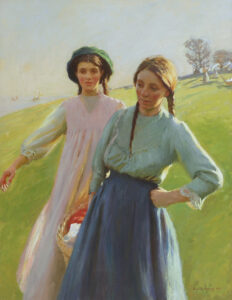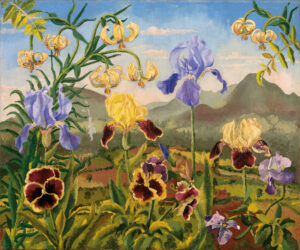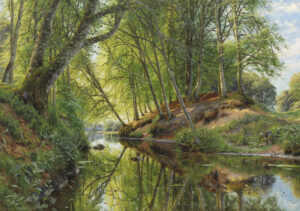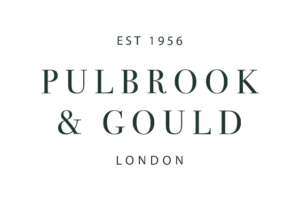The Art of Pictures, with David M. Mason
David M. Mason is the fourth generation an art dealing family that has been in business for over 130 years. Based in Duke Street, St James for the past 80 years, it now offers eight floors of display space across two galleries, with an inventory embracing Impressionism, 19th and 20th Century British Art, European Art, Sporting and Marine Art, and Sculpture.
As with silver collectors discussed by Oliver Newton in July’s issue of The Square, what collectors want most are the finest quality pictures and sculpture of their type. “Excellent provenance is also extremely important, and if a picture is in good original condition that can help with the price too. Naturally, we concentrate on acquiring the best examples by each artist that we exhibit.”
So, how do collectors differ between the fields in which MacConnal-Mason deal?
“It’s a very international business these days, and people’s tastes can be shaped by where they live and their other passions. In simple terms, on the whole young people tend to collect more recent paintings, but if someone is keen on horses or lives by the sea, they may want to buy equine or marine paintings too. Those who are into shooting and things like that might collect sporting paintings or select Victorian landscapes. Others, who have an interest in fashion might be interested more in figurative paintings. However, tastes are generally quite eclectic these days, and collectors will hold a variety of subjects and periods if they can. In the end, though, it’s all about how an individual work rings the bell for them.”
Attracting new clients and helping collectors develop their taste is another skill of the accomplished dealer. “It really is a journey,” says David. “People start collecting in one area and as their interests develop, they’ll broaden their horizons as well as deepening their focus. They could go from collecting Modern British paintings to developing a keen interest in the Newlyn School, and that can lead them towards more abstract paintings and, indeed, sculpture.”
Tastes change with the times, but real talent will remain popular through the ages, David believes. “While nobody is really interested any longer in many of the minor Victorian artists or the sort of grim subjects of the darker 19th century ‘morality’ paintings, amazing artists such as Sidney Richard Percy (d.1886) and John Atkinson Grimshaw (1836-93) remain timeless. Even so, paintings by the likes of Percy or sporting artists such as Herring have less value today than 20 years ago, but they are starting to rise slowly again, so it’s an area of the market that is very interesting now.”
Collectors should generally avoid works that are simply not in good condition, David advises, and he also has some tips on how to look after your art once you have taken it home.
“Insurance is relatively low because everything is recorded photographically these days, and it’s very easy to check the status of a work on the Art Loss Register to ensure that a painting has free title.
“Never hang a painting in direct sunlight and in the case of a watercolour I would want to have museum glass in front to take out the UV rays. If you are going to hang a picture above a radiator, it is a good idea to have the radiator boxed off, or at least have a shelf above it to defend the work against rising heat.”
Rediscovering artists and championing lesser names is another rewarding activity for dealers. At The Berkeley Square Fair, they will dedicate part of their stand to the work of Harold Harvey (1874-1941), a Cornish artist born in Penzance who worked in Paris before moving to Newlyn. There his studies of social realism gave way to gentler scenes of coastal life using a brighter palette reflecting the exceptional light of the area that attracted so many artists. Morning Sunshine, showing two girls carrying a heavy basket through a meadow shows how captivating his compositions could be.
Such works transcend age groups among collectors, says David.

Morning Sunshine by Harold Harvey, who will be the focus of a small exhibition on MacConnal-Mason’s stand at the fair.
Pride of place on the stand will go to an “exceptional” Cedric Morris with an outstanding provenance – a rediscovery. “Morris gifted it to Bettina Shaw-Lawrence (1921-2018) who studied under him at the East Anglian School of Art. It was her association with Lucien Freud that adds to the interest. It’s painted on both sides, the reverse with a cold Welsh cottage painted in the 1930s, and then later when materials were in short supply in the 50s, he painted the surrealist landscape on what is now the front.”

The rediscovered painting by Cedric Morris that belonged to Bettina Shaw-Lawrence. MacConnal-Mason plan to exhibit it at The Berkeley Square Fair.
Exhibiting at fairs is an essential part of the business. “It’s an excellent platform for meeting existing clients and for those we hope to meet. It’s at that point that we can start to develop a relationship and get them to come into the gallery. Without the fairs, we might not meet those future clients.”
Coming into the business as the fourth generation is a tremendous inheritance, but it can bring its own challenges.
“There can be underappreciated pressures. You have to really excel and work as hard as you possibly can to meet expectations, and you need to understand the business side of things every bit as much as you do the art. I’ve always thought of that sort of pressure as positive as it creates the incentive to learn more. It’s always very important to work hard if you want success.”
It could have all been different though. As he set out into the world of work in 1983, David first took on a job as a farm labourer in the South Hams area of Devon.
“It was on a dairy farm. The way of life was just amazing. I think working there and getting up really early and having a hard and solid day’s work instilled a work ethic in me. I absolutely loved it.”
However, a job at Christie’s called and so it was back to the world of art, and 40 years later the gallery continues to look to the future with the fifth generation in the shape of David’s son Matthew.
“We continue to move forwards and we’re always looking into new markets while retaining the existing markets that we’ve always dealt with and exhibiting internationally. At the moment we are excited about the potential for Danish paintings, which we regard as considerably undervalued. Look out for works by Peder Mørk Mønsted (1859-1941) and Carl Holsøe (1863-1935) on our stand at The Berkeley Square Fair!”

A wonderful Spring view by the Danish artist Peder Mørk Mønsted. MacConnal-Mason are focusing on Danish artists, whom they view as undervalued.





